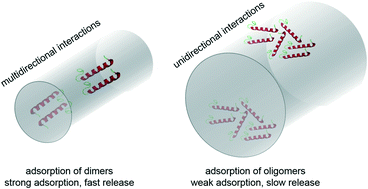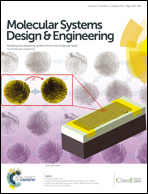Influence of mesopore size and peptide aggregation on the adsorption and release of a model antimicrobial peptide onto/from mesoporous silica nanoparticles in vitro†
Abstract
Mesoporous silica is a promising carrier for cationic peptides, as such peptides can be adsorbed onto silica through attractive electrostatic interactions. However, concentration-dependent peptide aggregation could influence the adsorption process itself, and may also influence the kinetics of peptide release. In order to shed more light on these processes, we chose to study the adsorption and release of a model antimicrobial peptide, salmon calcitonin, using three silica nanoparticles that are different in terms of pore size. It is shown that pronounced adsorption of calcitonin at low calcitonin solution concentrations was only observed when the mesopore size was in the range of the size of the peptide. When the mesopore size clearly exceeded the size of the peptide, very limited peptide adsorption was observed. In this case, pronounced peptide adsorption was only observed when the solution concentration of the peptide was so high that the peptide formed oligomeric aggregates in solution. The results clearly indicate that electrostatic attraction is not the only driver for peptide adsorption, but that the possibility for multivalent peptide–silica interactions in the case of the smaller-pore silica strongly enhances peptide adsorption. This conclusion is supported by results obtained for calcitonin adsorption to non-porous Stöber particles of similar size, where an adsorption behavior almost identical to that seen for the large-mesopore silica nanoparticles was observed. Interestingly, the release rates were also highly influenced by the nature of the adsorption, and very fast peptide release was observed for calcitonin loaded into the small-mesopore silica nanoparticles, while very slow release was observed for calcitonin adsorbed to the large-mesopore and the non-porous silicas. Such an adsorption–desorption behavior is opposite to that normally observed for small molecule–drug–silica nanoparticle combinations, and highlights the importance of taking peptide aggregation into account when designing mesoporous silica-based carrier systems for delivery of therapeutic peptides.

- This article is part of the themed collection: Engineering Nanoparticles for Sensing and Biomedical Applications


 Please wait while we load your content...
Please wait while we load your content...